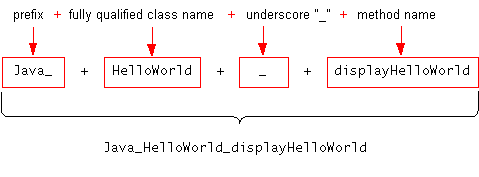Feedback Form
|
|
Start of Tutorial > Start of Trail > Start of Lesson |
Search
Feedback Form |
In this step, you use thejavahutility program to generate a header file (a.hfile) from theHelloWorldclass. The header file provides a C function signature for the implementation of the native methoddisplayHelloWorlddefined in that class.Run
javahnow on theHelloWorldclass that you created in the previous steps.The name of the header file is the Java class name with a
.happended to the end. For example, the command shown above will generate a file namedHelloWorld.h.By default,
javahplaces the new.hfile in the same directory as the.classfile. Use the-doption to instructjavahto place the header files in a different directory.
HelloWorld.h.
/* DO NOT EDIT THIS FILE - it is machine generated */
#include <jni.h>
/* Header for class HelloWorld */
#ifndef _Included_HelloWorld
#define _Included_HelloWorld
#ifdef __cplusplus
extern "C" {
#endif
/*
* Class: HelloWorld
* Method: displayHelloWorld
* Signature: ()V
*/
JNIEXPORT void JNICALL Java_HelloWorld_displayHelloWorld
(JNIEnv *, jobject);
#ifdef __cplusplus
}
#endif
#endif
Java_HelloWorld_displayHelloWorld function provides the
implementation for the HelloWorld class's native method
displayHelloWorld, which you will write in Step 4: Write the Native Method Implementation.
You use the same function signature when you write the implementation
for the native method.
If HelloWorld contained any other native methods,
their function signatures would appear here as well.
The name of the native language function that implements the
native method consists of the prefix Java_, the package
name, the class name, and the name of the native method. Between
each name component is an underscore "_" separator. Graphically, this looks as follows:

The native method displayHelloWorld within the
HelloWorld class becomes
Java_HelloWorld_displayHelloWorld. No package name appears in our example because HelloWorld is in the
default package, which has no name.
Notice that the implementation of the native function, as it appears in the header file, accepts two parameters even though, in its definition on the Java side, it accepts no parameters. The JNI requires every native method to have these two parameters.
The first parameter for every
native method is a JNIEnv interface pointer. It is
through this pointer that your native code accesses parameters and
objects passed to it from the Java application. The second parameter is
jobject, which references the current object
itself. In a sense, you can
think of the jobject parameter as the "this" variable in
Java. For a native instance method, such as the
displayHelloWorld method in our example, the jobject argument is
a reference to the current instance of the object. For native class methods, this argument
would be a reference to the method's Java class. Our example ignores both parameters. The next lesson,
Getting Started![]() , describes how to access data using the JNI interface pointer
, describes how to access data using the JNI interface pointer
env parameter. The next lesson also provides more information about jobject.
![]()
|
|
Start of Tutorial > Start of Trail > Start of Lesson |
Search
Feedback Form |